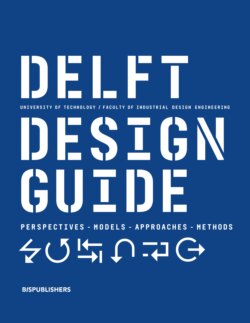Читать книгу Delft Design Guide -Revised edition - Annemiek van Boeijen - Страница 36
На сайте Литреса книга снята с продажи.
Оглавление34. Skilful Co-design
How? Design skills do not need to be present yet; they can be developed consciously by embedding the following three educational principles:
--------
Goal 1 – Sharing learning goals: When you as a designer can clarify the learning goals and can share concrete success criteria with participating users, the users are able to monitor and evaluate the quality of their own design processes and products. Learning goals are shared in parallel to the design goals, and this usually takes place before the actual design activity starts.
--------
Goal 2 – Scaffolding: Scaffolding gives people support to perform tasks that they are not able to do without help. Providing examples and demonstrations are a way to apply scaffolds. For
instance, a facilitator may demonstrate creative Brainstorming out loud. It was found that managers who received such a demonstration can generate roughly twice as many ideas and that their ideas were much more varied compared to managers receiving a normal instruction.
Templates can be used as a scaffolding strategy as well. In primary schools, using a template that helps to formulate design critique in constructive and inspiring phrases can avoid defensive reactions and improve the reception of such critique.
--------
Goal 3 – Feedback to skill development
Learning by doing requires moments of reflection on what has happened. It is crucial that the participants involved in a Co-design process receive timely feed- back, as feedback is necessary for them
in the process. Mid-term pauses during design activities enable participants to evaluate their own learning. Try focusing on a specific design skill and on related success criteria. For example, after shar- ing on how to think divergently, allow the participants to check after taking their break whether they think divergently and can understand how they can improve their thinking in the next brainstorm round.
--------
The principles described here can be applied throughout the Skilful Co-design process and can be used with differ- ent user groups, such as primary and secondary schools that have prioritised creativity and design thinking on the ed- ucational agenda. They can also be used in organisations that promote design skills among their non-design staff.
Skilful Co-design
What & Why? When users are involved in the design process they can enrich these processes with their context-specific and personal experiences. However, they may not have developed creative thinking and other design skills; this in turn impedes their contribution.
Key principles in Skilful Co-design include sharing learning goals, scaffolding, and providing intermediate feedback on the developed design skills. These allow for reflection on the design processes. The permanent growth in design skills brings value to the participants in exchange for their contribution, meaning that participants may be able to deploy these skills elsewhere. Due to the rapid changes in contemporary society, there is a need for people and organisations to tackle problems using approaches and methods from the design realm.
When designers embed learning activities in the Co-design process they receive higher quality contributions from more skilled participants. In addition, users are more willing to participate in Co-design sessions. In this way, users and their environment may become more sensitive and open, both to the final designs and to design thinking in general.
--------------------------------------------------------------------------------------------------------------
Mindset: In the perspective of Skilful Co-design, designers strive for a reciprocity in the investments and benefits between designers and participants.
References & Further Reading: Your Turn, toolkit for skilful co-design for use with 8 – 14 year old children: English version: www. tudelft.nl/codesignkids. Dutch version: www.tudelft.nl/yourturn / Klapwijk, R. & van den Burg, N., 2019. Formative assessment in primary education- Involving pupils in clarifying the learning goal of divergent thinking , PATT 37, 3-6 June, Malta, 277-287. / Schut, A., Klapwijk, R., Gielen, M., van Doorn, F., & de Vries, M., 2019. Uncovering early indicators of fixation during the concept development stage of children’s design processes. International Journal of Technology and Design Education , 1-22. / Gist, M. E., 1989. The influence of training method on self‐efficacy and idea generation among managers. Personnel psychology , 42(4), 787-805.
Tips & Concerns
Because learning principles are in- cluded in the process, participants can work more independently, and therefore it becomes possible for them to work with larger groups.
--------
Designers embedding educational principles may experience cognitive overload at first when they have the responsibility to achieve both learning and design output.
--------
When collaborating with teachers these trained educators can guide part of the Skilful Co-design process, and doing so can assist them in integrating the learning principles.
------------------------------------------
Limitations
Although design skills are improved, it may take some time before the learning has an effect on the quality of participants’ contributions..
Skilful Co-design is a perspective that values reciprocity – meaning a balance in the concerns of both the designers and the participants. This concept applies educational principles within the regular co-design process to improve the design skills of participants and consequently the quality of their contributions.
perspectives
---------------------------------------------------------------------------------------------------------------------------------------------------------------
---------------------------------------------------------------------------------------------------------------------------------------------------------------
35
